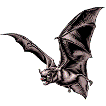Museum, University of Nebraska State

University of Nebraska State Museum: Mammalogy Papers
Document Type
Article
Date of this Version
12-23-1977
Citation
From Abstracts: Annual Meeting of the American Society of Zoologists and Society of Systematic Zoology. Hosted by the Canadian Society of Zoologists, December 27–30, 1977; Royal York Hotel, Toronto, Canada. Published in American Zoologist (1977) 17(4): 872.
Abstract
Insectivory as a specialized feeding condition in mammals has not been explored as has been carnivory or herbivory. Insect-feeding, non-edentate mammals have dilambdodont teeth and modifications in the craniomandibular joint which distinguish them from other mammals such as carnivores, herbivores, and omnivores. Variation in a family of insectivorous bats, Molossidae, can be likened functionally to the kinetic-inertial and static-pressure jaw systems noted in rhipidistians, amphibians, and reptiles. Food data show that the bats with the kinetic-inertial system eat moths and ones with the static-pressure system eat beetles. Not only do these insectivorous mammals eat insects, they also are modified to eat only certain types of insects.


Comments
Copyright © 1977, American Society of Zoologists. Used by permission.